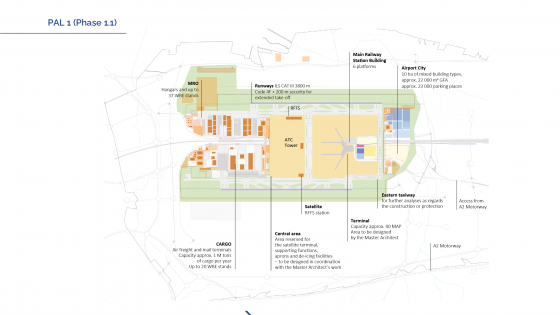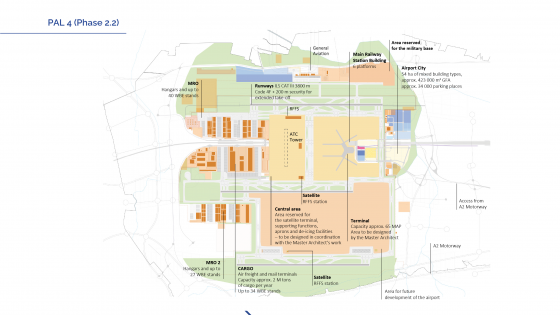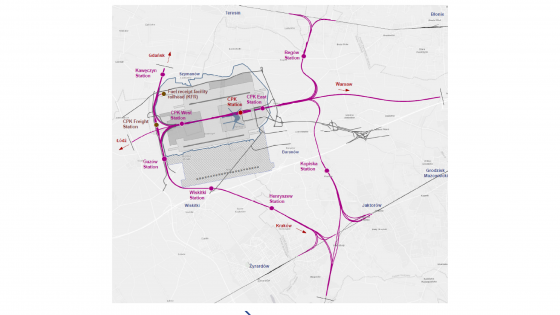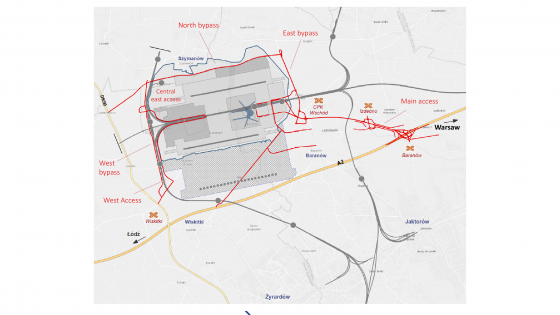Centralny Port Komunikacyjny (CPK) has published details of its airport master plan, a key document setting out the long-term concept for the airport’s development.
The plan provides guidance for designers and contractors, and is a key source of information on the assumptions and plans for the development of a multimodal hub that integrates air, rail and road transport.
June 2023 saw the approval of the general plan, a document required by aviation law in order to obtain approvals and acceptance at government levels for the construction of a new airport. The newly published document is a summary of the full airport master plan, which provides guidelines for planners and developers concerning the airport and the rail and road node: from the vision and strategic objectives through the variants analysed during the planning work, the location details, the sustainability concept, airport layout and phasing for all key areas including airside, passenger terminal, railway station, landside area, cargo area, MRO area, and other infrastructure.
Only one of Poland's 15 public airports – Katowice Airport – has published its current master plan online. For comparison: in the UK, 30 airports provide such documents, and their development is preceded by detailed environmental studies and extensive public consultations, as in the case of CPK.
“The publication of the CPK airport master plan ensures that the assumptions and plans for the construction of this much needed investment are transparent and publicly available. It is also the next step in the investment process. We have moved from the planning stage to the advanced design. Property acquisitions are progressing quickly on the project site as well as demolitions and geological boreholes,” said Marcin Horała, deputy minister of funds and regional policy and government plenipotentiary for CPK.

The newly published document provides guidelines for planners and developers
“This document is a summary of months of work on the long-term development concept for the airport and the multimodal CPK hub. The master plan presents considered variants and the stages of airport development. We intend to provide passengers with opportunities for comfortable travel by combining different modes of transport in one place. A key element of the designed infrastructure is the first railway station integrated in such a way with the airport,” said Mikołaj Wild, president of CPK.
The document outlines the stages of CPK airport development: from its launch, which is planned for 2028, through the subsequent stages until 2060 – the end date of the aviation forecast for the Polish market created by the International Air Transport Association (IATA).
The need for flexibility
The master plan is in line with IATA's forecasts, which were created assuming three scenarios – low, baseline and high – taking into account the impact of the COVID-19 pandemic. According to the baseline scenario, the level of 40 million passengers should be reached around 2035, which would imply the need for infrastructure expansion. In 2060, it is anticipated that nearly 65 million passengers per year are going to be using CPK. Transfer traffic is forecast to account for around 40% in the initial period of the airport's operation and to increase to between 45 and 50% in the long term.

The airport plan was devised with future expansion in mind
The document indicates that through flexible design it should be possible to expand the terminal, aprons and other infrastructure in a modular way to ensure the efficient operation of the entire hub. On opening, the CPK airport is going to have two parallel runways, each 3,800m long, separated by a 2,500m midfield where the necessary infrastructure will be located, including a passenger terminal with a multimodal hub and a railway station, aprons and de-icing pads, as well as an air traffic control tower. A reserve for future expansion of the third runway, which may be needed in the next stage of the airport’s development, is located to the south of the two currently designed runways.
In the view of the growing demands for sustainability and green buildings, the master plan assumes that the airport should be ready for net-zero CO2 emissions right from launch, by providing ground handling infrastructure consisting of zero-emission vehicles and sourcing energy from renewable sources.

The railway node will connect CPK with lines to Warsaw, Łódź and Wrocław, Poznań, Kraków and Katowice, Tricity and Rzeszów
The station
A railway station with six underground platforms serving long-distance, regional and commuter connections is going to be integrated with the terminal. Thanks to the new high-speed railway lines built by the company and the modernisation of the existing railway network, travel times between the CPK airport and Warsaw and the largest cities in Poland should not exceed 2.5 hours.
The railway line, which is planned to be put into service with the opening of the airport, will connect Warsaw and Łódź with CPK, plugging the airport into the high-speed railway system. The CPK railway station is the centre of a railway node connecting CPK with lines towards Warsaw, Łódź and Wrocław, Poznań, Kraków and Katowice, Tricity and Rzeszów.
The results of the passenger transport model (PMT) forecasts indicate that ultimately around 40% of passengers are going to commute to the airport by rail, with around 50% using cars and taxis while the remainder use buses and other modes of transport. In the longer term, there are also plans to extend the Warsaw Commuter Rail (WKD) line from Grodzisk Mazowiecki to the CPK passenger terminal.
Two additional railway stops will be built within the airport, operated by regional trains. The CPK East stop is to provide access to the Airport City (hotel, office, conference and administrative facilities). The CPK West stop will serve a cargo zone (the CPK Freight station for handling freight to be built in the western part of the interchange). The cargo terminals for airfreight are to be located on the western side of the airport.
Based on IATA forecasts, the master plan works on the assumption that the new CPK infrastructure, combined with the lack of restrictions experienced at Chopin Airport, should unlock Polish air cargo potential. According to forecasts, cargo and air mail transport combined is expected to reach around 1 million tonnes as early as 2035 (before COVID-19 it was around 100,000 tonnes).

CPK will be connected to the extended A2 motorway
The master plan also takes into account the preliminary road layout around the airport, which is undergoing in-depth analysis and agreements with the General Directorate for National Roads and Motorways (GDDKiA). It will connect the airport to the extended A2 motorway, National Road no 50 (DK50) and the planned Warsaw Agglomeration Bypass (OAW).
Images: Centralny Port Komunikacyjny
